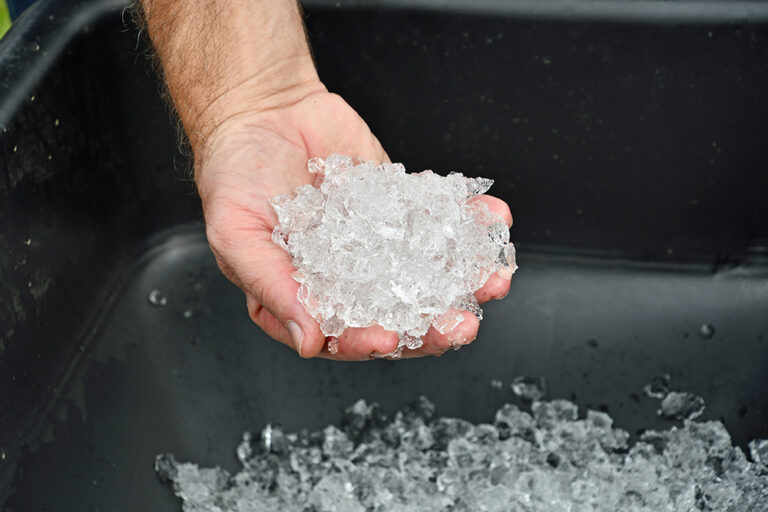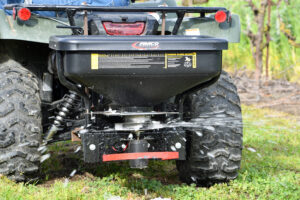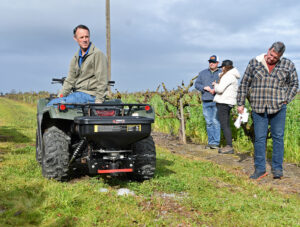
Researchers are looking to the super-absorbent hydrogel technology behind disposable baby diapers as part of a possible ant management system.
\Although the hydrogels still need California Department of Pesticide Regulation (CDPR) approval for use as adjuvants, David Haviland, UCCE integrated pest management advisor in Kern County, said he’s hopeful it will come shortly.
Developing better ant control is part of an integrated approach to reducing the amount of grapevine leafroll associated virus-3 and vitivirus in grape vines, said Stephanie Bolton, Lodi Winegrape Commission grower research and education director. That’s because ants transport and tend vine mealybugs within the vineyard for their honeydew. In addition, ants disrupt integrated pest management by protecting mealybugs from natural predators. Mealybugs, in turn, transmit viruses as they feed on the vines.
If growers can reduce ant populations, then along with other IPM measures like mealybug mating disruption, biological control and roguing infected vines, they should in theory be able to help slow virus spread.
Haviland, who has been working on a gel ant bait system with Extension colleagues for several years, demonstrated mixing and application during a recent Lodi Winegrape Commission field day in a Lodi-area vineyard.
He’s not alone. Monica Cooper, UCCE viticulture advisor for Napa County, conducted a pilot study in 2015 followed by two years of replicated field trials in North Coast vineyards in 2016 and 2017 looking at gel-based ant baits. She found the system significantly reduced Argentine ant populations providing users correctly identified the target ant species and the pesticide concentration in the gel mixture produced delayed toxicity.
Chlorpyrifos Alternatives
The latest round of gel ant bait trials was a result of a $1.34 million CDPR grant looking at alternatives to chlorpyrifos, a now-banned insecticide. The researchers focused on ant species that feed on sugar.
Commercial ant baits that attract protein- or lipid-feeding ants, such as Southern fire ants or pavement ants, are already available. Almond growers, for example, apply them to their orchards about six weeks before harvest to control ants that feed on almonds drying on the ground after shaking.
These baits typically use soybean oil as an attractant and contain a small amount of a toxicant or insect growth regulator. The theory is worker ants take the material back to the colony, where they feed it to other workers, larvae and the queen. Eventually, the colony collapses. If the pesticide acts too quickly, it kills off only a portion of the workers, and the colony can rebuild.
Know Thy Ant Species
Proper ant identification is important to determine whether ants are pests and to ensure the correct bait. More than 275 ant species are found in the state, but only a handful are considered agricultural pests, Haviland said.
In Lodi-area vineyards, the main ant pests are the native gray ant (Formica aerate) and pavement ant (Tetramorium immigrans), while in North Coast vineyards and southern San Joaquin Valley grapes and citrus, Argentine ants (Linepithema humile) are the predominant ant pest.
Native gray, pavement and Argentine ants are attracted to sugar-containing substances, including honeydew produced by Asian citrus psyllid (which can transmit citrus greening, also known as huanglongbing) and mealybugs.
Monitoring can be done using cotton balls soaked in a 25% sugar water solution. Sample one out of every 20 rows. Within the target row, place a cotton ball within 5 inches of a vine trunk once every 30 vines.
Wait two hours and return to count the number of ants. Rather than counting individual insects, Haviland said it’s often easier to score them zero for none, 1 for a few, 2 for about 11 to 49 and 3 for 50 or more.

Seeking Better Ant Control
Baits for sugar-feeding ants must be in liquid form to be attractive, so granulated sugar doesn’t work well. In addition, sugary liquid baits only work during the spring. Once insect pests begin producing honeydew, ants will instead gravitate toward them.
Although liquid bait dispensers are available for sugar-feeding ants, Haviland said the number required per acre to be effective in vineyards makes them unfeasible for commercial growers. That led researchers to look at hydrogels that can retain moisture for several hours as potential carriers.
UC Riverside Biological Control Specialist Mark Hoddle examined sodium alginate gels made from seaweed as carriers for minute amounts of pesticides. After two years of trials in citrus, he found the gel baits significantly reduced ants, which allowed natural enemies to attack the psyllid as well as other sap-sucking pests. As a result, the amount of new citrus flush infested with Asian citrus psyllid decreased by 75%, and the number of citrus mealybugs were reduced by 50%.

Haviland and Cooper, on the other hand, looked at polyacrylamides. They are the same materials used in ultra-absorbent baby diapers as well as to increase soil water-holding capacity in container-grown plants. The products are also available in macrobins.
When used to prolong irrigation in plants, polyacrylamides are considered soil amendments and don’t need CDPR registration, Haviland said. When used as part of ant baits, they are considered pesticide carriers and therefore classified as adjuvants. In California, adjuvants also must undergo CDPR registration, he said.
Haviland said they are working with the citrus and the wine and table grape industries to request a Section 18 emergency use exemption for the gels.
Off-the-shelf polyacrylamides come in granular or crystal form and change into gels as they absorb water. In the case of the ant bait, the researchers mixed four parts water and one part granulated sugar to which they added an “ultra-low” amount of insecticide. Once they created a solution, they added polyacrylamide and allowed the mixture to sit for at least two hours in a properly labeled, covered container to rehydrate.
Water quality, such as salinity and hardness, may affect gel formation, said Nathan Mercer with CDFA. As a UC Berkeley Department of Environmental Science, Policy and Management post-doctoral researcher, he was involved in the Lodi trials in 2022 and 2023. Mercer recommended users first mix a jar of the gel to test water quality.

Lodi Trials Targeted Pavement Ants
In the Lodi trials, researchers looked at four insecticides, all used at a fraction of the labeled rate: boric acid, thiamethoxam, abamectin and pyriproxyfen. They applied the gel bait at either 5 gallons per acre or 10 gallons per acre using a hand spreader the first year. During the second year, they used a Herd spreader hitched to an ATV.
Calibration and maintaining an even speed are important to ensure users aren’t over- or under-applying the gel bait, Haviland said.
Users should try to apply the gel bait early in the morning, under foggy or cloudy conditions, and aim for the shade under canopies to prolong moisture as much as possible, Haviland said. Under optimum conditions, the bait will remain attractive for up to two days before it dries out.
Conversely, he advised against applying it under the blazing sun in the middle of the day when the gel may dry out in less than two hours.
The researchers also compared plots that received only one treatment to those that had received two applications.
“All the insecticides worked pretty well to some degree at both 5 gallons and 10 gallons per acre,” Mercer said. “All did a good job of keeping down the pavement ants, especially Platinum (thiamethoxam). Platinum did a really good job after just one application.”
In the plots that received two thiamethoxam treatments, the researchers saw a 38% reduction in vine mealybug numbers in grape clusters.
North Coast Trials Looked Good, Too
Cooper looked at polyacrylamide gel bait laced with boric acid at 0.05% or thiamethoxam at 0.0006% active ingredient. She also found both worked well.
In vineyards treated with two applications of thiamethoxam-laced bait, ant foraging was eliminated for five to six weeks, and activity was further suppressed for up to six months. Ant activity was based on sugar water-laced cotton ball surveys.
In vineyards treated with two applications of boric acid-laced bait, ant foraging was eliminated for four to six weeks, and activity was further suppressed for up to five months.
Cooper said the overall ant population declines suggest the effects of bait applications over multiple seasons are cumulative.
Start Early
For the ant baits to be successful, Haviland provided a few caveats. They are only effective in the spring before pests begin to exude honeydew.
“Once you get honeydew, the ants are smart; they know the difference between sugar water from Walmart and filet mignon,” he said.
In addition, the ants must be foraging, which typically starts in mid-March in the interior and southern regions of California, whereas in the North Coast region it may be later. Survey ants with sugar-soaked cotton balls to determine site-specific differences in timing.
As part of a vine mealybug program in interior and southern regions of California, Haviland recommended a gel ant bait application about April 1, followed by a second about four weeks later if needed based on ant surveys.
The costliest ingredient in the gel bait is granulated sugar, and Haviland said he plans to conduct trials this season to see if cutting the amount in half to an 8:1 water-to-sugar ratio will be as attractive to ants as using a 4:1 rate.











